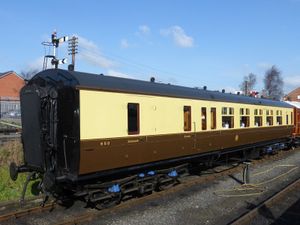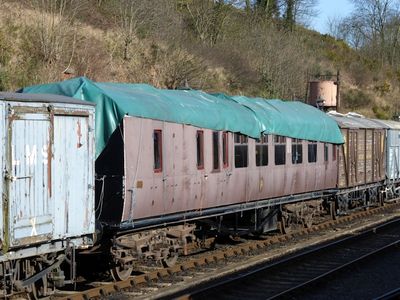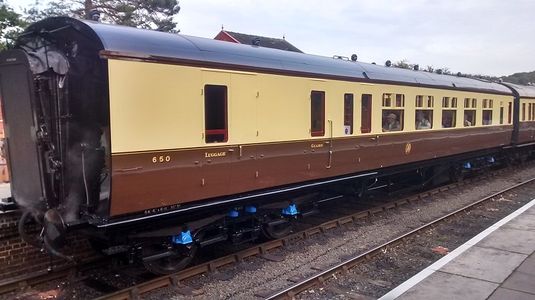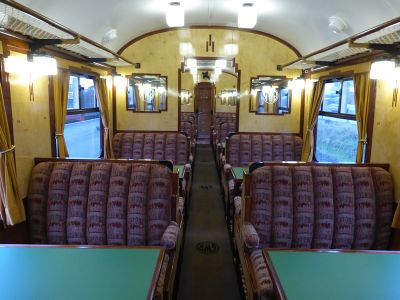Difference between revisions of "GWR 650 Brake Third Open (Excursion)"
m |
(GWR locks resolution) |
||
| (3 intermediate revisions by 2 users not shown) | |||
| Line 1: | Line 1: | ||
{{Infobox carriage | {{Infobox carriage | ||
| − | |image = | + | |image = GWR_650_20160305a.jpg |
| − | |caption = 650 at | + | |caption = 650 at Kidderminster (2016) |
|construc = GWR Swindon | |construc = GWR Swindon | ||
|status = In use | |status = In use | ||
| Line 26: | Line 26: | ||
|years6 = | |years6 = | ||
|events6 = | |events6 = | ||
| − | }}GWR Brake Third Open (BTO) | + | }}[[File: GWR_650_20160305b.jpg|thumb|300px|right|650 at Kidderminster (2016)]] |
| + | '''GWR 650 Brake Third Open''' (BTO) is the only surviving example of a brake coach from GWR 'excursion stock'. It arrived on the SVR as a grounded body in 1990 and finally entered service in 2015 after a lengthy restoration. | ||
| − | == | + | ==Excursion stock== |
| − | + | The GWR generally favoured corridor carriages with compartments, using open carriages only for dining cars. However in 1935, some years after the other 'big 4' companies had done so, CB Collett introduced the GWR's '''excursion stock'''. These were arguably the first 'modern' GWR carriages, although the GWR initially emphasised that they were only for excursion or party-hire traffic with catering capable of being provided to every seat. They had a length of 60ft and featured spacious windows, while the 'art deco' style interior was panelled in light birchwood with mahogany trim and inlays, the other woodwork being polished mahogany. The light fittings were opaque glass cubes and the upholstery was a new 'standard' type.<ref>[[Bibliography#Other References|Harris (1966)]] p. 100.</ref><ref group="note">1935 was the centenary of the founding of the GWR. It was marked by the introduction from 8 July 1935 of new 61ft 'Centenary stock' on the prestige 'Cornish Riviera Express' service, restyled as the 'Cornish Riviera Limited'. The Centenary stock adopted a similarly modern appearance.</ref> | |
| − | + | By 1938 the excursion stock numbered some 55 third opens and 10 brake third opens together with eight kitchen cars, although in practice the excursion stock often ran as short sets of eight or less without the kitchen cars. The third opens all seated 64 passengers at tables in conventional style. The first four BTOs had an unusually large luggage compartment which took up half the length of the coach, resulting in there being seating for only 16 passengers, while the others had a smaller luggage compartment allowing for seating for 32. | |
| − | 650 returned to service as part of a special train on 11 October | + | 12 more third opens were built in 1969 and a final six third opens and two brake third opens, including No. 650, were completed in 1940. The last 2 BTOs had even smaller luggage compartments, allowing for seating for 40 passengers. These 1939-40 sets are not thought to have run as formations and a number of them were quickly marshalled in casualty evacuation trains. |
| + | |||
| + | Post-War the excursion stock remained in use by BR with little modification, although they were frequently seen in 'normal' service. The last of the stock had been withdrawn by 1966; only three examples of the third opens have been preserved, while 650 is the only surviving example of an excursion stock brake third open<ref>[[Bibliography#Other References|Longworth (2018)]] , Various pages</ref><ref>[[Bibliography#Other References|Harris (1966)]] p. 101., Appendix "Lot List"</ref>. | ||
| + | |||
| + | ==650 in service and preservation== | ||
| + | GWR Brake Third Open (BTO) No 650 was built at Swindon in April 1940 as lot number 1644 to diagram D130. It was later numbered W650W by BR(W) in accordance with the normal [[Carriage and Wagon numbering|post-nationalisation numbering practice]] and was eventually withdrawn from service in October 1964.<ref>[[Bibliography#Other References|Longworth (2018)]] p.77.</ref> The following year the body of the coach was grounded at Kerne Bridge in the Wye Valley where it was used as a dormitory for the Gloucester Boys Club.<ref>SVR Stock Book Ninth Edition</ref> | ||
| + | |||
| + | 650 was purchased from Kerne Bridge in 1989 by the [[Great Western (SVR) Association]] as a long-term restoration project. It was initially moved to the [[Foley Park sidings|British Sugar Corporation's sidings beside the SVR at Foley Park]] in March 1990. While there, some frame repairs and external repanelling were carried out.<ref>SVR News 128, Autumn 1998</ref> | ||
| + | |||
| + | On 31 March 2000, 650 was moved by road from Foley Park to Kidderminster and placed on accommodation bogies in preparation for a move to Bewdley.<ref>SVR News 133</ref> However other GW(SVR)A vehicles still required restoration, in particular [[GWR 9103 Nondescript Saloon]], so 650 was then stored in [[Kidderminster Carriage Shed]] while parts for the restoration were sourced and a set of bogies was overhauled. A number of new brass fittings were cast, as pictured on the GW(SVR)A web site [http://www.gw-svr-a.org.uk/650_restoration2.html 650 Brass Fittings] page. | ||
| + | |||
| + | By July 2007 650 had been moved into Kidderminster Carriage Works to have the underframe riveted up and other work caried out by the SVR's C&W staff as a contract job. After that time the GWR(SVR)A kept a photographic record of the restoration which may still be found on the GW(SVR)A web site [http://www.gw-svr-a.org.uk/650_restoration.html 650 Restoration] page. | ||
| + | |||
| + | On 29 September 2010 650 was moved to Bewdley to be assessed for further contract work to make it watertight. By that time the GW(SVR)A had launched an appeal to raise funds for its restoration. Restoration work then continued in Bewdley paint shop with the help of full-time staff and support assistance from the [[Guarantee Company]] Board in early 2011. By the end of 2011 the exterior was complete and had received a protective coat of brown paint, allowing it to be moved out into the yard where work on the internal fit out could continue for the next three years. 650 returned to the paint shop in April 2015 for final painting into GWR 1934-42 livery featuring the ‘shirt-button’ roundel. It then moved to [[Carriage Repair Works|Kidderminster]] for final mechanical work to the dynamo and vacuum braking system and mounting on its own bogies. | ||
| + | |||
| + | The restoration of 650 was completed on 8 October 2015. Three days later 650 returned to service as part of a special train on 11 October 2015. In November 2015 it was allocated to [[Carriages#Set S | Set S]], the Severn Valley Limited dining set. | ||
| + | |||
| + | Most of the GW carriages are fitted with so-called ‘snap’ locks; when the handle is vertical the door is unlocked, and when the handle is horizontal the door is securely locked. In 2023 these vehicles were temporarily withdrawn from service following concern over the locks, following incidents where the door was fully closed but left unsecured as the handle was not turned to the horizontal position.<ref>[https://www.svrlive.com/blmay23 Branch Lines May 2023]</ref> At the [[Autumn Steam Gala]] 650 was the first vehicle to return to service with a 1921 GWR modification to the tongue of the lock, operating in a three-coach local set. | ||
==Gallery== | ==Gallery== | ||
| − | <gallery> | + | <gallery mode=packed heights=200px style="text-align:left"> |
| − | + | GWR_650_20150307.jpg| 650 during restoration in early 2015 | |
| + | GWR650.jpg | 650 at Arley on its first day in service in 2015 | ||
| + | GWR_650_Interior_20151122.jpg|Interior view of 650 | ||
</gallery> | </gallery> | ||
==See also== | ==See also== | ||
| − | [[Carriages| List of carriages]]< | + | *[[Carriages| List of carriages]] |
| + | |||
| + | ==Notes== | ||
| + | <references group="note"/> | ||
==References== | ==References== | ||
| Line 54: | Line 77: | ||
[[Category: Carriage Type BTO]] | [[Category: Carriage Type BTO]] | ||
[[Category: Rolling stock owned by the Great Western (SVR) Association]] | [[Category: Rolling stock owned by the Great Western (SVR) Association]] | ||
| + | [[Category:Featured articles]] | ||
Latest revision as of 22:47, 25 September 2023
| GWRGreat Western Railway 650 Brake Third Open (Excursion) | |
|---|---|
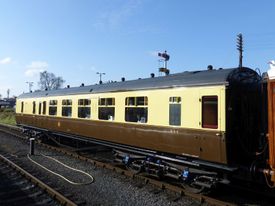 650 at Kidderminster (2016) | |
| Built By | GWRGreat Western Railway Swindon |
| Status | In use |
| Number | 650 |
| Other numbers | W650, W650W |
| History | |
| Built | 1940 |
| Designed By | Charles CollettCharles Benjamin Collett, Chief Mechanical Engineer (CME) of the Great Western Railway 1922-1941 |
| Diagram | D130 |
| Lot | 1644 |
| Type | BTO |
| Length | 60ft 11¼in |
| Weight | 30t 5cwt |
| Seats | 40 third |
| 1989 | Entered preservation |
| 2015 | Restoration completed |
GWRGreat Western Railway 650 Brake Third Open (BTO) is the only surviving example of a brake coach from GWRGreat Western Railway 'excursion stock'. It arrived on the SVRSevern Valley Railway as a grounded body in 1990 and finally entered service in 2015 after a lengthy restoration.
Excursion stock
The GWRGreat Western Railway generally favoured corridor carriages with compartments, using open carriages only for dining cars. However in 1935, some years after the other 'big 4' companies had done so, CB CollettCharles Benjamin Collett, Chief Mechanical Engineer (CME) of the Great Western Railway 1922-1941 introduced the GWRGreat Western Railway's excursion stock. These were arguably the first 'modern' GWRGreat Western Railway carriages, although the GWRGreat Western Railway initially emphasised that they were only for excursion or party-hire traffic with catering capable of being provided to every seat. They had a length of 60ft and featured spacious windows, while the 'art deco' style interior was panelled in light birchwood with mahogany trim and inlays, the other woodwork being polished mahogany. The light fittings were opaque glass cubes and the upholstery was a new 'standard' type.[1][note 1]
By 1938 the excursion stock numbered some 55 third opens and 10 brake third opens together with eight kitchen cars, although in practice the excursion stock often ran as short sets of eight or less without the kitchen cars. The third opens all seated 64 passengers at tables in conventional style. The first four BTOs had an unusually large luggage compartment which took up half the length of the coach, resulting in there being seating for only 16 passengers, while the others had a smaller luggage compartment allowing for seating for 32.
12 more third opens were built in 1969 and a final six third opens and two brake third opens, including No. 650, were completed in 1940. The last 2 BTOs had even smaller luggage compartments, allowing for seating for 40 passengers. These 1939-40 sets are not thought to have run as formations and a number of them were quickly marshalled in casualty evacuation trains.
Post-War the excursion stock remained in use by BRBritish Rail or British Railways with little modification, although they were frequently seen in 'normal' service. The last of the stock had been withdrawn by 1966; only three examples of the third opens have been preserved, while 650 is the only surviving example of an excursion stock brake third open[2][3].
650 in service and preservation
GWRGreat Western Railway Brake Third Open (BTO) No 650 was built at Swindon in April 1940 as lot number 1644 to diagram D130. It was later numbered W650W by BRBritish Rail or British Railways(W) in accordance with the normal post-nationalisation numbering practice and was eventually withdrawn from service in October 1964.[4] The following year the body of the coach was grounded at Kerne Bridge in the Wye Valley where it was used as a dormitory for the Gloucester Boys Club.[5]
650 was purchased from Kerne Bridge in 1989 by the Great Western (SVR) Association as a long-term restoration project. It was initially moved to the British Sugar Corporation's sidings beside the SVR at Foley Park in March 1990. While there, some frame repairs and external repanelling were carried out.[6]
On 31 March 2000, 650 was moved by road from Foley Park to Kidderminster and placed on accommodation bogies in preparation for a move to Bewdley.[7] However other GW(SVR)AGreat Western (SVR) Association vehicles still required restoration, in particular GWR 9103 Nondescript Saloon, so 650 was then stored in Kidderminster Carriage Shed while parts for the restoration were sourced and a set of bogies was overhauled. A number of new brass fittings were cast, as pictured on the GW(SVR)AGreat Western (SVR) Association web site 650 Brass Fittings page.
By July 2007 650 had been moved into Kidderminster Carriage Works to have the underframe riveted up and other work caried out by the SVRSevern Valley Railway's C&WCarriage & Wagon staff as a contract job. After that time the GWRGreat Western Railway(SVRSevern Valley Railway)A kept a photographic record of the restoration which may still be found on the GW(SVR)AGreat Western (SVR) Association web site 650 Restoration page.
On 29 September 2010 650 was moved to Bewdley to be assessed for further contract work to make it watertight. By that time the GW(SVR)AGreat Western (SVR) Association had launched an appeal to raise funds for its restoration. Restoration work then continued in Bewdley paint shop with the help of full-time staff and support assistance from the Guarantee Company Board in early 2011. By the end of 2011 the exterior was complete and had received a protective coat of brown paint, allowing it to be moved out into the yard where work on the internal fit out could continue for the next three years. 650 returned to the paint shop in April 2015 for final painting into GWRGreat Western Railway 1934-42 livery featuring the ‘shirt-button’ roundel. It then moved to Kidderminster for final mechanical work to the dynamo and vacuum braking system and mounting on its own bogies.
The restoration of 650 was completed on 8 October 2015. Three days later 650 returned to service as part of a special train on 11 October 2015. In November 2015 it was allocated to Set S, the Severn Valley Limited dining set.
Most of the GW carriages are fitted with so-called ‘snap’ locks; when the handle is vertical the door is unlocked, and when the handle is horizontal the door is securely locked. In 2023 these vehicles were temporarily withdrawn from service following concern over the locks, following incidents where the door was fully closed but left unsecured as the handle was not turned to the horizontal position.[8] At the Autumn Steam Gala 650 was the first vehicle to return to service with a 1921 GWRGreat Western Railway modification to the tongue of the lock, operating in a three-coach local set.
Gallery
See also
Notes
- ↑ 1935 was the centenary of the founding of the GWRGreat Western Railway. It was marked by the introduction from 8 July 1935 of new 61ft 'Centenary stock' on the prestige 'Cornish Riviera Express' service, restyled as the 'Cornish Riviera Limited'. The Centenary stock adopted a similarly modern appearance.
References
- ↑ Harris (1966) p. 100.
- ↑ Longworth (2018) , Various pages
- ↑ Harris (1966) p. 101., Appendix "Lot List"
- ↑ Longworth (2018) p.77.
- ↑ SVRSevern Valley Railway Stock Book Ninth Edition
- ↑ SVRSevern Valley Railway News 128, Autumn 1998
- ↑ SVRSevern Valley Railway News 133
- ↑ Branch Lines May 2023
Links
| ||||||||||||||||||||||||||||||
